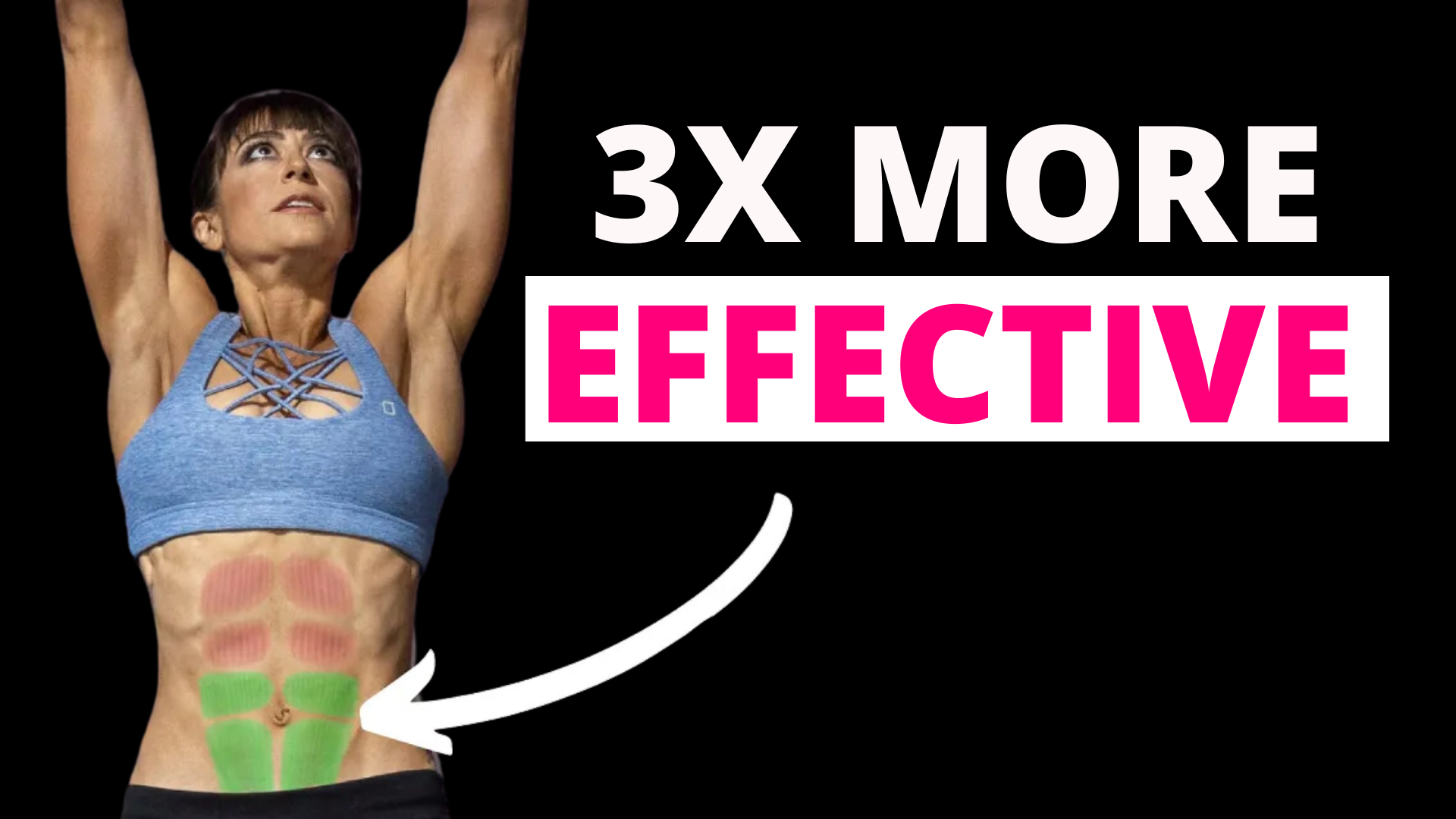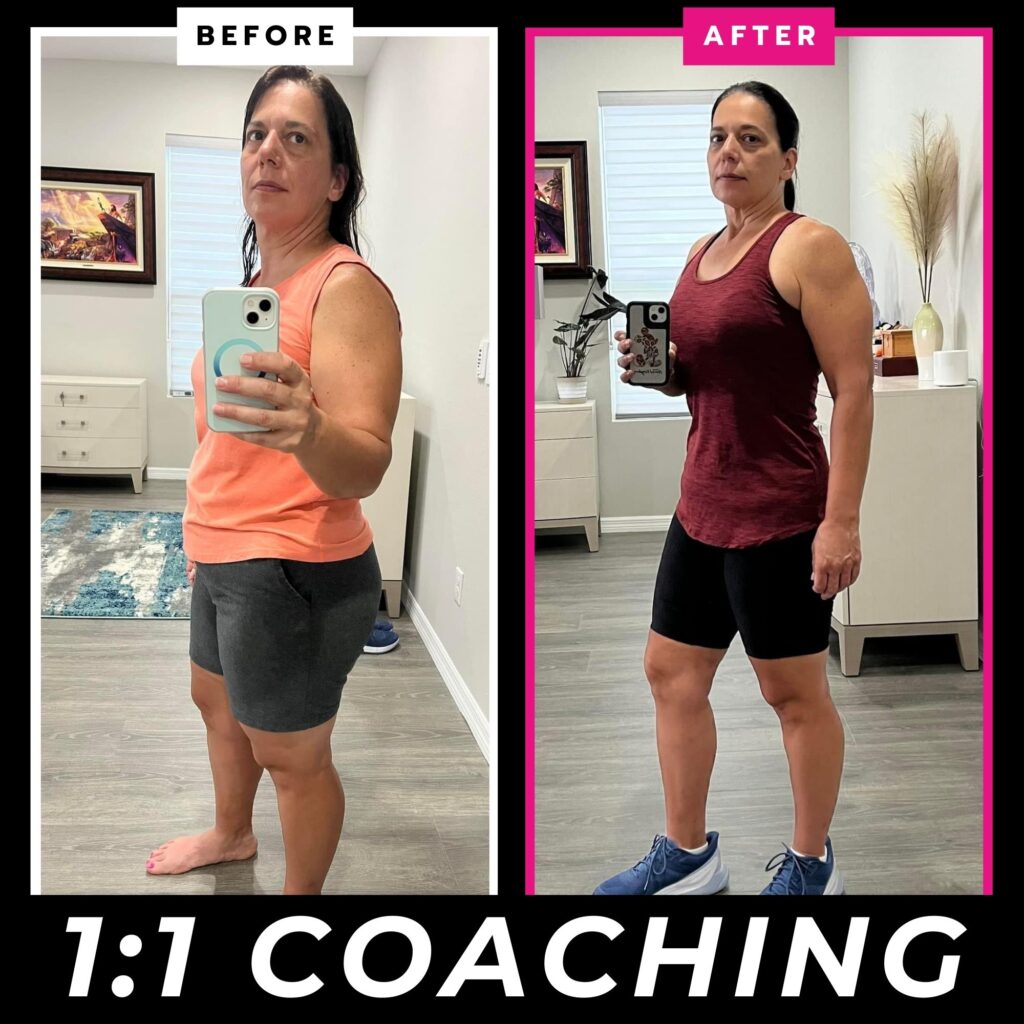Guess what 1 of these 10 tips isn’t…
DO MORE!
Because too often in doing more we make our workouts less effective.
We waste time and energy.
And then we blame a lack of time for our lack of progress or our ability to stick with our plan.
We even start to get frustrated with our lack of results for all the effort we put in.
And this is because we’re constantly just doing more.
Which is why I think this first rule is so key….

#1: Design With Purpose.
Everything in your workouts should be done with a strategic reason behind it that drives you forward.
We only add reps or sets because that volume or training density is needed.
We change up tempos or types of moves or where we hold the weights because it targets what we need to work in the way we need to work those muscles.
We aren’t just including supposedly best moves.
We’re including moves that match OUR needs and goals and current fitness level and progressing and evolving those over time as our needs and goals change.
And if your goal is weight loss especially, you don’t just want to have the purpose of your sessions to be “burn more calories…
Which is why rule number 2 is
#2: Set A PERFORMANCE Focus.
While yes, working out does help us burn more calories and can be a way to create that calorie deficit for weight loss, seeing our workouts only as important for the calorie burn undervalues them.
It is also what leads to use often just doing more or workout harder only to end up frustrated when results don’t happen faster.
We end up wasting more time and effort.
And we often then give up when we aren’t seeing quicker changes on the scale.
But true body recomp, losing fat as you gain or retain muscle, is a SLOW process.
To help yourself stay consistent, it is key you also set performance goals for your sessions.
This allows you to measure success in other ways to keep implementing the habits you need to reach your goals.
It also helps you design your workouts to have progression and build.
So even if your ultimate goal is to lose weight, consider setting a goal for your workouts to also lift more weight on your deadlift or master that push up from your toes.
This will keep you pushing hard in your sessions to see those results snowball and allow you to design everything with a clear focus that is even more trackable to adjust!
Then just because you have the time, doesn’t always mean you need to use it.
Third Rule…Don’t just let workouts fill the time allotted.
Whether you have 30 minutes to train or an hour, you can design a workout to work for that time.
But just because you have the hour doesn’t mean you’ll always need to use it based on your goals or current fitness level.
The intensity you want to train at and what you want to work on should dictate how long the session is…not just how long you have.
If you’re wanting to include sprint work, you may only need 20 minutes, especially if working on more speed or power.
You don’t want to do wasted volume training at a lower intensity just to do more and fill the hour.
And if you do really want to fill the hour, maybe you do so by adding in mobility work.
However, you may need an hour if you’re planning to work on 1 rep max lifts.
Having only 30 minutes to train wouldn’t be ideal for this as you need long rest periods and more time to really hit the volume you need.
Design for the time you have to make your schedule work and see results, but also don’t just use the time because you have it!
Don’t waste your time…especially if you’ve ever used the excuse “I don’t have enough time!” as a reason to skip your session!
And to help you get the most out of each session, you need to focus on pushing that progression.
You need to find ways to challenge yourself.
Which means you’re not always just doing the top reps listed!
This 4th rule is really about pushing that comfort zone and not just stopping at the top amount of reps assigned because…well it’s the top of the rep range listed.
Especially if you’re advanced exerciser, you may even really want to push that lower end of the rep range in your programming.
You may even find you want to error on hitting 7 reps to then STICK at that weight until you can do 10-12 reps with it before then again increasing.
But if you want better results, even if a weight feels hard for the top end of the rep range, GO UP as long as you can maintain form.
Do fewer reps with that heavier load to challenge yourself and add reps the next week to progress!
And then remember that adding weights, or even reps, aren’t the only ways to advance your workouts and drive those results.
Rule 5…Create Progression Through The Same But Different.
I think progression through the use of different movement variations is too often undervalued and underutilized.
The smallest of small tweaks is sometimes all we need to see results and bust through a plateau.
Because changes in movements can activate muscles to different extents, putting a different emphasis on what is working while challenge our mind-body connection in new ways.
Slight changes in our posture or position with an exercise can have an impact.
Like the chin up or underhand grip vs. the pull up or overhand grip.
The underhand grip emphasizes more bicep and requires less scapular control while the overhand grip emphasizes the back more, requiring more control of those shoulder blades to engage the lats.
Both can and should be used based on what you need!
Diversity when used strategically can be used to our advantage – it just needs to be included with purpose.
And we need to be intentional with those moves we use.
We can’t just seek to zone out and be mindless with our workouts if we want better results.
We can’t just try to get through or rush through the workout.
We need to truly focus on what we feel working and push ourselves…which is uncomfortable.
That’s why this next rule is…Is to be intentional and present.
This is something I harp on probably to an annoying extent with clients and one of the issues I have with follow along workouts.
With those workouts, people just try to keep up. Or do what the instructor is doing.
They aren’t focused on what they feel working or what they need to do.
They’re often just going through the motions, thinking even that doing a harder move is better.
But every move is earned.
And doing a harder move isn’t better if we aren’t working the correct muscles.
Honestly it can be worse, leading to overload and injury.
It can mean we’re doing a ton of moves that aren’t fully paying off!
If you want to get the most out of your workouts, you want to feel the correct muscles working. You want to be focused to truly push your boundaries and challenge yourself!
Because just going through the motions may mean we’re spending time training, but not maximizing that effort!
Because where our attention goes, our energy flows.
And this is even why rule #7 is to…
Pay Attention To Workout Order
This rule honestly means a few different things…
It means putting exercises in specific orders based on your goals, prioritizing lifts first that you want to be freshest for so you can lift heavier, while honing in on muscles with more isolated moves as you fatigue…
It means being strategic in how you include strength vs. cardio sessions, prioritizing what you value and want to be freshest for first…
Like if you’re training for a race, cardio should be done first.
However, if body recomp is your goal, strength work should be done first with cardio implemented strategically after or even on other days.
And even order how you split up what muscles you work and the moves you include should be considered for over the course of your weekly schedule.
For example, putting heavy barbell deadlifts earlier in your week may be key, especially if you’ve ever struggled with back pain as you want that move after you’ve had rest days and are fresh instead of later in your week when muscles may be tired.
You may even notice that by changing order of moves, you feel different things working!
Ever been sore from a previous workout, where maybe you did more core work, to only then realize how much your core is engaging during push ups later that week?
That exercise order has an impact!
But no matter what order you choose to include moves in…
There’s one thing you can’t skip to start EVERY single session.
And that’s your warm up.
But if you want to get more out of your training, a warm up isn’t just about “getting warm.”
It’s about actually MOBILIZING those joints and prepping your body for work.
Your warm up should be about addressing previous injuries, movement compensations and even daily postures that may impact your workout as you also warm up your body.
You want to make yourself get benefit out of that very first rep of your training session vs. feeling like it takes you a few rounds to get into things.
A proper warm up helps you make sure you’re able to strengthen through a full range of motion and engage the correct muscles so you don’t compensate, which can lead to injury.
So focus your warm ups on foam rolling to relax overactive and tight muscles…
Dynamic stretching to mobilize joints and improve your flexibility…
And then activation to establish that mind-body connection to get underactive muscles working and improve your stability.
You’ll be amazed at how much that warm up you want to skip now really pays off so you get more out of your workouts and aren’t being sidelined with injuries or feeling like you’re recovery is super slow!
Which actually leads me to the final 2 essential rules…and something that can be mentally hard to embrace when we equate feeling worked and working harder to better results faster…
But no pain, no gain is not the best attitude to have!
Rule #9…Soreness can’t be the goal and Rule #10…Low intensity sessions are essential!
We can only train as hard as we can recover from.
And if every session is leaving us feeling destroyed…
We will start to see our performance and results go backward as we aren’t giving our body the recovery it needs to rebuild
And…
We may end up burned out and injured struggling to find the motivation to get back into things
Basically we’ll be working hard to see lackluster results.
And I mentioned soreness because too often we seek to be sore and use that as a judgement of working hard enough.
But soreness doesn’t mean our workouts are moving us forward.
We can be sore because of the types of moves we include or even because we did NEW moves.
Soreness is even an indication that we aren’t creating clear progression but just randomly stringing things together that aren’t building or even that our recovery in between sessions, such as our fueling isn’t on point.
Not being sore isn’t a bad thing.
It may even be a good sign you’re progressing at an appropriate pace.
However, because of building and even moves like the deadlift that cause more muscle tissue damage, you may get sore at times even with proper recovery.
This though is why lower intensity sessions can be key.
They mentally help you recharge and allow you to move in a non-stressful way that can even enhance recovery.
So don’t skip the yoga or the mobility work or even that casual walk because it doesn’t feel as worth it…because it may be the key to getting more out of your other sessions!
SUMMARY:
The more purposeful and intentional we are with our training, the better and faster the results we will see.
Don’t just go through the motions or string together random free workouts that look hard.
Stay focused on your needs and goals and create a plan to move forward!
Want amazing workouts to help you rock those results?
Check out my Dynamic Strength program!




I truly love everything you said and it’s so right on. I don’t exercise however in my job I am constantly moving and lifting. I wish I can find someone to help me lose 15 pounds and put on muscle. I would truly like that. Trainers now are about the money. That’s what I get when I talk to a trainer. They don’t outright say it but well what ever. Thankyou for the honestly. Wish I had someone like you as a trainer.
Glad the tips help!